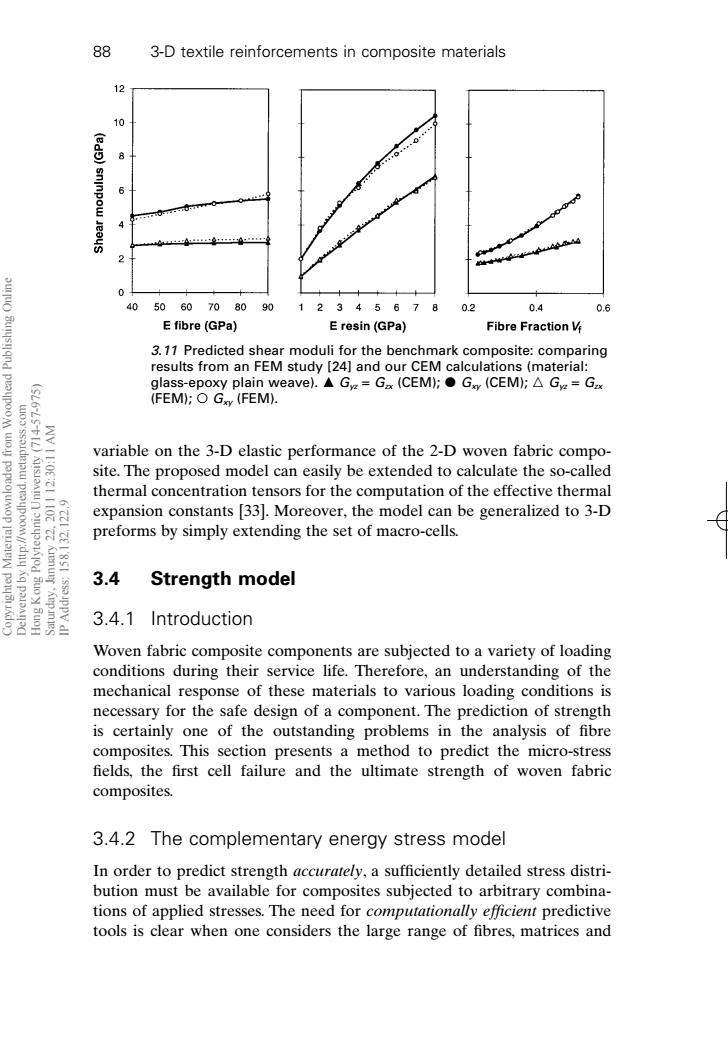正在加载图片...

88 3-D textile reinforcements in composite materials 12 10 40 5060708090 12345678 0.2 0.4 0.6 E fibre(GPa) E resin(GPa) Fibre Fraction V 3.11 Predicted shear moduli for the benchmark composite:comparing results from an FEM study [24]and our CEM calculations(material: glass-epoxy plain weave.▲Gz=Gx(CEM:●Ggy(CEM;△Ga=Gzx 195650t1 (FEM);O Gxy(FEM). WV IL:OE variable on the 3-D elastic performance of the 2-D woven fabric compo- site.The proposed model can easily be extended to calculate the so-called 202 thermal concentration tensors for the computation of the effective thermal expansion constants [33].Moreover,the model can be generalized to 3-D preforms by simply extending the set of macro-cells. 3.4 Strength model 豆 3.4.1 Introduction Woven fabric composite components are subjected to a variety of loading conditions during their service life.Therefore,an understanding of the mechanical response of these materials to various loading conditions is necessary for the safe design of a component.The prediction of strength is certainly one of the outstanding problems in the analysis of fibre composites.This section presents a method to predict the micro-stress fields,the first cell failure and the ultimate strength of woven fabric composites. 3.4.2 The complementary energy stress model In order to predict strength accurately,a sufficiently detailed stress distri- bution must be available for composites subjected to arbitrary combina- tions of applied stresses.The need for computationally efficient predictive tools is clear when one considers the large range of fibres,matrices andvariable on the 3-D elastic performance of the 2-D woven fabric composite. The proposed model can easily be extended to calculate the so-called thermal concentration tensors for the computation of the effective thermal expansion constants [33]. Moreover, the model can be generalized to 3-D preforms by simply extending the set of macro-cells. 3.4 Strength model 3.4.1 Introduction Woven fabric composite components are subjected to a variety of loading conditions during their service life. Therefore, an understanding of the mechanical response of these materials to various loading conditions is necessary for the safe design of a component. The prediction of strength is certainly one of the outstanding problems in the analysis of fibre composites. This section presents a method to predict the micro-stress fields, the first cell failure and the ultimate strength of woven fabric composites. 3.4.2 The complementary energy stress model In order to predict strength accurately, a sufficiently detailed stress distribution must be available for composites subjected to arbitrary combinations of applied stresses. The need for computationally efficient predictive tools is clear when one considers the large range of fibres, matrices and 88 3-D textile reinforcements in composite materials 3.11 Predicted shear moduli for the benchmark composite: comparing results from an FEM study [24] and our CEM calculations (material: glass-epoxy plain weave). Gyz = Gzx (CEM); Gxy (CEM); Gyz = Gzx (FEM); Gxy (FEM). RIC3 7/10/99 7:37 PM Page 88 Copyrighted Material downloaded from Woodhead Publishing Online Delivered by http://woodhead.metapress.com Hong Kong Polytechnic University (714-57-975) Saturday, January 22, 2011 12:30:11 AM IP Address: 158.132.122.9 ��